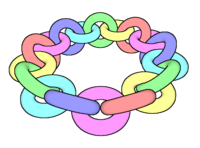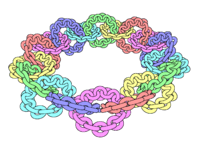Antoine's necklace


In mathematics, Antoine's necklace, discovered by Louis Antoine (1921), is a topological embedding of the Cantor set in 3-dimensional Euclidean space, whose complement is not simply connected. It also serves as a counterexample to the claim that all Cantor spaces are ambiently homeomorphic to each other.
Construction
Antoine's necklace is constructed iteratively like so: Begin with a solid torus A0 (iteration 0). Next, construct a "necklace" of smaller, linked tori that lie inside A0. This necklace is A1 (iteration 1). Each torus composing A1 can be replaced with another smaller necklace as was done for A0. Doing this yields A2 (iteration 2).
This process can be repeated a countably infinite number of times to create an An for all n. Antoine's necklace A is defined as the intersection of all the iterations.
Properties
Since the solid tori are chosen to become arbitrarily small as the iteration number increases, the connected components of A must be single points. It is then easy to verify that A is closed, dense-in-itself, and totally disconnected, having the cardinality of the continuum. This is sufficient to conclude that as an abstract metric space A is homeomorphic to the Cantor set.
However, as a subset of Euclidean space A is not ambiently homeomorphic to the standard cantor set C. That is, there is no bi-continuous map from R3 → R3 that carries C onto A. To show this, suppose there was such a map h : R3 → R, and consider a loop k that is interlocked with the necklace. k cannot be continuously shrunk to a point without touching A because two loops cannot be continuously unlinked. Now consider any loop j disjoint from C. j can be shrunk to a point without touching C because we can simply move it through the gap intervals. However, the loop g = h−1(k) is a loop that cannot be shrunk to a point without touching C, which contradicts the previous statement. Therefore, h cannot exist.
Antoine's necklace was used by Alexander (1924) to construct Antoine's horned sphere (similar to but not the same as Alexander's horned sphere).
See also
References
- Antoine, Louis (1921), "Sur l'homeomorphisme de deux figures et leurs voisinages", Journal Math Pures et appl., 4: 221–325
- Alexander, J. W. (1924), "Remarks on a Point Set Constructed by Antoine", Proceedings of the National Academy of Sciences of the United States of America, 10 (1): 10–12, doi:10.1073/pnas.10.1.10, JSTOR 84203, PMC 1085501
 , PMID 16576769
, PMID 16576769 - Brechner, Beverly L.; Mayer, John C. (1988), "Antoine's Necklace or How to Keep a Necklace from Falling Apart", The College Mathematics Journal, 19 (4): 306–320, doi:10.2307/2686463, JSTOR 2686463
- Pugh, Charles Chapman (2002). Real Mathematical Analysis. Springer New York. pp. 106–108. doi:10.1007/978-0-387-21684-3. ISBN 9781441929419.